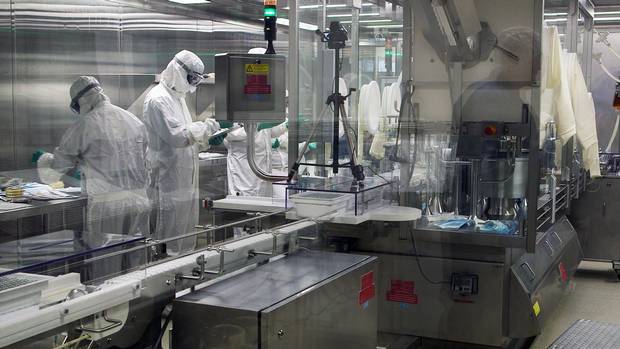In a small room at GlaxoSmithKline's sprawling vaccine manufacturing plant in Sainte-Foy, Que., two workers clad in hazmat gear are overseeing the fate of this year's flu shot. A powerful heat lamp removes the outer packaging from a container of syringes before a conveyor belt transports them for filling and fitting with needles and stoppers. The air in the room is changed dozens of times an hour in order to keep the environment sterile.
This is just one step in the six-to-eight-month process of getting the yearly influenza vaccine ready for the public. Although this year's flu season is just beginning, preparations have been under way at plants such as this one for the better part of a year.
During vaccine production, the facility uses approximately 360,000 eggs a day to incubate the flu virus before they are inactivated and processed. The finished vaccine is stored in a large temperature-controlled tank before a small hose-like line is used to fill thousands of vials and syringes. After multiple quality-control measures to catch mistakes, and a final safety check that looks for 37 possible defects, a finished batch is deemed ready for shipment.
This laborious process must be repeated each year: Unlike vaccines for other illnesses, the flu shot has to be remade from scratch every year because the viruses in circulation mutate each flu season.

Workers at the Sainte Foy Vaccine Production Facility in Quebec City, Quebec
GlaxoSmithKline
It's an imperfect system, but it's the best we have. However, there is hope for a more efficient way: a universal flu vaccine that could offer an individual years – perhaps even a lifetime – of protection against all influenza strains. Around the world, researchers are working to develop a new vaccine that focuses on the part of the flu virus that remains the same each year instead of the part that changes.
It's a major uphill challenge, but recently, Canadian researchers have found a way to force the immune system to target the static part of the flu vaccine. It's an exciting step that some experts say brings the possibility of a universal flu vaccine one step closer to reality.
Theresa Tam, deputy chief public health officer of Canada, said "everybody who is interested in influenza" is hopeful about the future of a universal vaccine and the prospect of doing away with the time-consuming, expensive yearly flu shot program, which is "unlike any other vaccine program that we have."
"Everybody's trying to find … a vaccine that's universal," said John Dorsey, head of vaccines at GSK. "This is the holy grail of flu vaccines."
Understanding influenza
Graphics by Trish McAlaster, animations by Ben Barrett-Forrest
Influenza virus particles are spherical in shape and covered by a multitude of proteins called hemagglutinin. The hemagglutinin are shaped like a lollipop, complete with a distinct "head" and "stalk" portion. Many researchers use the analogy of a lollipop to explain how hemagglutinin works: The head of the lollipop can lock into our cells, enabling the flu virus to replicate and cause illness.
The flu vaccine uses versions of the circulating strains of the flu virus – typically dead virus particles – to spur the immune system to produce antibodies, which are Y-shaped molecules. Antibodies bind to the head of the hemagglutinin, which prevents them from locking into our cells.
Each year, the head of the hemagglutinin changes, which means the antibodies produced last year likely won't work against the new flu strain. Typically, the flu virus doesn't change too drastically, so a person that received a flu shot last year, but not this year, will still produce antibodies that attempt to bind to the hemagglutinin head.
But the mutations mean the antibodies can't effectively stop virus particles from locking into cells and causing illness. So every year, Canadians are told to get a new flu shot to help protect themselves from getting sick. It's a costly, resource-intensive annual ritual, but remains the best way to prevent the spread of the flu.
Even then, there is no guarantee the flu shot will protect everyone against getting sick. On average, vaccines offer about 50-per-cent to 70-per-cent protection. Some years, the flu shot may not be a good match to the virus strains that are circulating. The effectiveness also varies depending on a person's health status.
For instance, older people may not develop sufficient antibodies – the body's ammunition to block virus particles from entering cells – to keep from getting sick. That's one reason why public health officials urge everyone to get vaccinated, so that those with weakened immune systems are better protected from catching the flu.
The process of making vaccines for the coming flu season actually begins around February, before the current flu season is over. That's around the time when the World Health Organization issues its recommendations to countries such as Canada on which viruses are most likely to be in circulation in the coming year and, therefore, should be included in the vaccine. Then, provinces place their orders with GSK and other manufacturers.
This year, the flu shot protects against two influenza A strains, H1N1 and H3N2, and a B strain (Brisbane/60/2008-like virus). According to the Public Health Agency of Canada, children, adults with chronic health conditions and health-care workers can get a quadrivalent vaccine that contains an extra B strain. Dr. Tam said Canada purchased 11.6 million doses of the flu shot at a cost of about $75-million for this season.
Many researchers and public health officials are hopeful a better system will come along that will not only streamline the current process and save the health-care system money, but offer people much stronger protection against a range of flu viruses.
Building a better vaccine
The ever-changing head of the hemagglutinin is a perpetual thorn in the side of flu-prevention initiatives. But there is one aspect of the lollipop-shaped hemagglutinin that stays the same year after year: the stalk portion. So all scientists need to do is develop a vaccine that produces antibodies that target the stalk instead of the head, right? Except this requires finding a way to override the body's natural immune response, which is to target the hemagglutinin head. In other words, it's a monumental challenge.
However, there is good reason to be optimistic about the future as researchers inch closer to cracking this elusive code. Matthew Miller, assistant professor of biochemistry and biomedical sciences at McMaster University in Hamilton, is one of the people at the forefront of this research.
In a recent interview, he explained how he and his colleagues found a way to force the immune system to target the stalk, which could open the door to a universal flu shot. A major development came during the H1N1 influenza pandemic in 2009. After examining the blood of those infected with the virus, Dr. Miller noticed something strange happening. Instead of producing antibodies targeting the hemagglutinin head, the immune system mounted a response to the stalk. Eventually, the researchers discovered the distinct nature of the pandemic virus caused the change in immune response.
The 2009 H1N1 virus was a new strain humans hadn't been exposed to before. The hemagglutinin head was vastly different from previous viruses, so the immune system didn't recognize it and failed to produce antibodies. But the immune system did recall seeing the stalk portion, which is the same in every flu virus. So that's where it focused its attack.
Except instead of producing antibodies that stuck onto the stalk, they attached themselves to human cells infected with the flu virus. The antibodies sticking out of those cells sent a signal to white blood cells to attack and kill the infected cells, stopping the virus in its tracks.
John Schrader, professor in the department of medicine at the University of British Columbia, has also published research showing the immune system mounts a stalk-targeting response when exposed to a flu virus with a novel hemagglutinin head. In an e-mail, he explained that this could be instrumental in developing a better flu vaccine. He said one option would be to give people a series of prepandemic vaccines that have a similar stalk but new, unfamiliar heads. Or it could be done by synthetically producing a virus that have familiar stalks attached to new, distinct heads, which is what Dr. Miller and his research colleagues are pursuing.
According to Dr. Miller, this finding represents a promising bet going forward for the development of a universal flu vaccine. By engineering a pandemic-like virus with a distinct hemagglutinin head, albeit an inactive harmless one, scientists will be able to create a vaccine that forces the immune system to focus its sights on the stalk, which could bring immunity to all influenza A viruses.
Next steps
So far, animal trials have been promising and it's expected that human trials could begin as soon as the next year, Dr. Miller said. But there's still a long way to go. The first step will be determining whether the immune system even responds to this new type of vaccine and, if it does, whether it actually works at preventing the flu.
This new universal vaccine also only targets influenza A viruses, Dr. Miller said. Researchers are working on a version for B strains, but it may be more challenging.
Dr. Schrader said that so far, no major safety concerns have arisen. But a number of questions remain, particularly figuring out how long this new universal vaccine lasts, he said. It's not something that can happen overnight.
"I think we still are looking at about 10 years," Dr. Schrader said.
MORE FROM THE GLOBE AND MAIL


